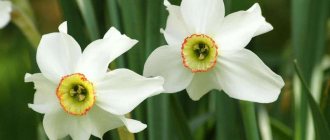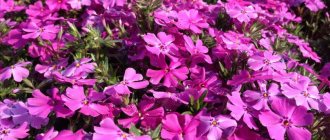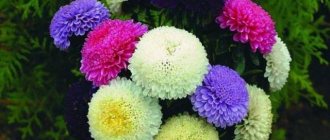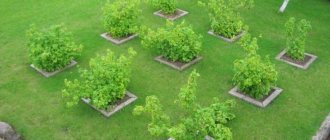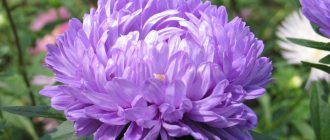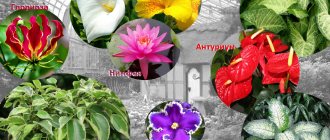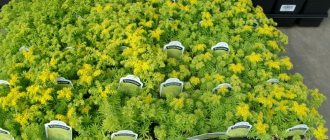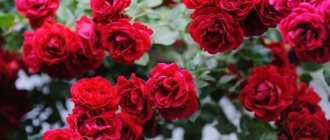What flowers are not afraid of drought?
You don’t have the time and opportunity to provide timely watering to your flower beds? Do flowers wither and dry up in the sun? The correct selection of drought-resistant plants that will not lose their appearance and will remain fresh even during the dry period will help solve the problem. These plants came to us from deserts or semi-deserts. Thanks to the special structure of leaves, stems and roots, they are adapted to high temperatures and drought.
If you're not sure whether a plant is adapted to living in dry conditions, look at its leaves. If they are “velvety” or “waxy”, we can say that the crop is adapted to the sun and will forgive you for rare watering.
When the flowerbed is constantly exposed to sunlight, you can decorate it with cheerful flowers. Drought-resistant plants, which are perennial and annual, will help you in this matter. Separately, drought-resistant grasses and shrubs are distinguished.
Drought-tolerant perennials :
- periwinkle;
- coreopsis;
- edelweiss;
- creeping phlox;
- sedums;
- evening primrose;
- sage;
- thrift;
- feverweed;
- splint;
- lavender;
- sagebrush;
- thyme;
- poppies;
- mallows.
Drought-resistant perennials
Drought-resistant annuals :
- annual asters;
- spurge;
- purslane;
- nasturtium;
- amaranth;
- Snapdragon;
- marigold;
- zinnias.
Drought-tolerant annuals
Drought-tolerant grasses and shrubs :
- gray fescue;
- cotoneaster horizontal;
- Cossack and common juniper.
Drought-resistant herbs and shrubs
Even dry, infertile soil, including sandy or rocky soil, is suitable for the growth of the listed plants.
It is impossible to talk in detail about each of the listed plants in one article. Therefore, we will focus on only five of them: echinacea, alpine aster, sedum, thyme and decorative onions. They are beautiful, unpretentious and combine well with each other, so they can be used in landscape design at the same time.
Designing flower beds with drought-resistant flowers
When creating a flower garden that will decorate the site for many years, it is necessary to take into account a number of points:
- Place of arrangement. Drought-resistant flowers feel comfortable in depleted soils. But they do not tolerate marshy soils where there is no sufficient outflow of moisture. On waterlogged soils they simply rot and die. Reliable soil drainage is a prerequisite when arranging flower beds. When laying out flower beds, the factor of illumination of the area is also important, because some drought-resistant flowers love sunny areas, while others love shady places.
- Combination of plants. When selecting compositions, it is important to take into account the conditions for growing a particular species. Plants with different moisture needs may feel uncomfortable in close proximity. And with such a combination of plants, the gardener may have difficulties with watering.
- Creating conditions for growth. To ensure reliable drainage, a sufficient amount of gravel and sand must be added to the soil. It is advisable to water only in the morning, thereby reducing moisture loss during the day. Plants must be planted at a sufficient distance from each other, leaving room for free growth of their above-ground parts.
Since most drought-resistant plants in nature grow on depleted soils and soils lacking vitamins, when preparing a flower garden it is better to limit the amount of organic fertilizers. The opinion that drought-resistant plants look inconspicuous compared to their sun- and moisture-loving counterparts is wrong. Among the drought-resistant plant species you can find many bright and showy decorative flowers.
Beautifully flowering, drought-resistant perennials are unpretentious in nature and can grow even on depleted soils. Many gardeners love drought-resistant plants not only for their unpretentiousness and beauty. A pleasant aroma always hovers around flower beds with these plants, attracting insects that pollinate the flowers. But even among the variety of beautiful drought-resistant plants, there are clear favorites that, even with insufficient care, can delight with lush, unique flowering throughout the season.
Drought-tolerant echinacea is a useful perennial
The main advantages of this highly decorative plant are durability and resistance to weather conditions. According to many gardeners, this is the most spectacular perennial, producing color in July-August.
Echinacea flowers resemble large multi-colored daisies with a convex core. The diameter of flower baskets ranges from 11-14 cm.
Echinacea is great for bouquets. In addition, by cutting flowers, you give the plant strength to form new buds. Bright “daisies” will delight you until autumn.
What does echinacea look like?
The best types and varieties:
- Echinacea strange is the only one of the genus that can boast a bright yellow color;
- Echinacea purpurea - meter-tall powerful bushes with dense foliage and bright purple inflorescences with a brown core;
- White Swan - greenish-yellow center edged with white petals;
- The king is two-meter “giants” with amazingly beautiful large (up to 15 cm) pinkish flowers;
- Cranberry muffin is a beautiful double variety with pink and purple flowers.
Many gardeners grow the plant not only for decorative purposes.
Echinacea is famous for its medicinal properties. Infusions and decoctions from it help fight colds and infections. Echinacea is included in many homeopathic and medicinal preparations.
The time for sowing seeds is late autumn or early spring. Planting material is sown directly into open ground without prior stratification. There is a possibility that out of the entire packet of seeds, only a few will be viable.
If you are not sure about the quality of the seeds, it is better to buy cuttings.
The plant feels better on calcareous or slightly alkaline dry nutrient soils. Before planting, the sandy soil is enriched with organic matter.
The bush grows in one place for three to four years.
For the winter, the bushes are pruned and covered with dry leaves.
Low-growing perennial sun-loving flowers for the garden
It is not always possible to boast of enough territory to grow tall crops. So what should you plant in the sun? In this case, you will need to plant low-growing sun-loving flowers in the flowerbed. Let's look at the most prominent representatives of drought-resistant perennial ground covers.
Unique sedums
Sedums (sedums) are distinguished by a variety of leaves that have interesting shapes, sizes and colors. There are about 600 varieties of such crops, all of them have a unique appearance, will decorate any flower bed, and will be a good solution for creating borders.
Flowering sedums
To obtain beautiful and original “carpets”, it is recommended to divide the sedums every 5 years and then replant them. There are varieties of sedums of different heights, but they all prefer sunny areas with loamy or sandy soil. When the flowering period of crops is over, be sure to cut off the stems and mulch the rosette using garden compost.
Miniature salvia
Salvia is a beautiful sun-loving plant that reaches different heights (from 0.3 to 1.5 meters), this depends solely on the variety. The stems of the crop are tetrahedral, the flowers can be red, lilac, blue, yellow, purple, white or pink.
Salvia in the garden
Perennial salvias require systematic pruning to maintain their beautiful shape. To prolong the flowering of bushes, you need to get rid of wilted flowers in time. For the winter, it is better to cover salivia with garden compost to ensure a high-quality wintering of the crop.
Refined nemophila
Low bright bushes reaching a height of 0.25 meters. They are distinguished by incredibly beautiful flowering and have interesting openwork leaves. Most often planted as a frame for flower beds and borders. Will please with long flowering throughout the summer.
The flowers come in different colors - from white with black dots to blue, dark purple shades. The soil suitable for crops is nutritious and permeable. During severe droughts, nemophiles need abundant watering. Reproduction is mainly by seed.
Exquisite saxifrage
Another wonderful sun-loving flower for a flower bed is saxifrage. The height of the bushes is up to 5-70 centimeters, they have elongated creeping stems. The leaves can be smooth or slightly pubescent, usually have a dark green color, there are representatives of a silver, gray, bluish tint.
Saxifraga blooms from May to August; small but exquisite flowers abundantly cover the bushes. The buds resemble bells, are white in color, and are also found in a yellowish, pinkish or red hue.
In spring and summer, saxifrage requires fertilizer. They are held 2 times a month. It is best to alternate organic fertilizers with mineral ones.
Original sun-loving perennial flowers for the garden will be an ideal solution for decorating any corner of the site where ultraviolet rays reach. Select bright crops to create interesting compositions and enjoy the results.
Sedums for a bright floral carpet
This is an excellent option for alpine slides. Such plants quickly grow in strength and look fresh, even when the grass turns yellow from the heat. During the flowering period, they are completely covered with bright inflorescences.
If you plant low varieties of sedum, it will seem as if the ground is covered with a flower mat.
Plants are decorative not only during the flowering period; their dense, thick leaves also look quite impressive.
What do sedums look like?
The best types and varieties:
- Sedum sedum - forms a low decorative green mat up to 7 cm high, looks especially impressive when covered with bright yellow flowers;
- Evers sedum is an excellent border sedum. The shoots are woody, the leaves are round with a blue tint. In August, small pink inflorescences appear;
- White sedum - it is better to plant on poor soils, otherwise the plant will quickly cover the entire ground with a low (up to 4 cm) carpet. During the flowering period, flower stalks rise, strewn with snow-white small and very fragrant flowers;
- Sedum reflexum grows in a bluish twenty-centimeter mat; at the beginning of summer, yellow flowers bloom on tall (up to 30 cm) peduncles.
Any well-drained soil containing compost or humus is suitable for growing sedums. The main care is to regulate the growth of the plant, otherwise the sedum may grow and occupy the entire flowerbed.
Selecting plants for a dry garden
Annuals
The ease of caring for annuals, their ability to add new colors to the flower garden every year, the most amazing forms and their inexhaustible variety have and will continue to attract flower growers.
Among the flowering annuals, we can recommend the following plants for a drought-resistant garden:
- Zinnia (Zinnia) is an annual flowering plant with a height of 30 to 90 cm. The leaves are located opposite each other, the stem and leaves are rigidly pubescent. It blooms in temperate latitudes from June to frost, the inflorescence is a basket, there are a wide variety of shades, the seeds have time to ripen and do not lose their germination for 2-4 years. Based on two types of zinnias - graceful and narrow-leaved, many varieties have now been bred for growing in flower beds.
- Rudbeckia is an annual or perennial flowering plant. The leaves are oval below, lanceolate above. The flower is a basket with tubular and reed flowers. The tubular flowers form a brown tubercle, characteristic of this species. The flowers are similar to daisies and are usually yellow or orange. The seeds are tetrahedral, small.
- Cosmos is a tall flowering plant imported from South America. The leaves are twice pinnately dissected, giving the plant an openwork appearance. The flowers are large, on long bare stems, the color ranges from white or pale pink to purple. The seeds ripen very well and reproduce by self-sowing.
- Ornamental sunflower species (Helianthus annuus) is an annual tall plant, up to 2.5 m. The leaves are heart-shaped, arranged alternately. The stem and leaves are rigidly pubescent, the flower is a basket with dark tubular flowers and yellow petal flowers. The seeds are wedge-shaped, smooth, slightly pubescent.
- Ornamental poppy (Papaver rhoeas) is an annual plant that comes in many varieties with varying colors. This light-loving plant is planted in separate group plantings on a lawn or flower bed, as well as in a group of different varieties.
Rudbeckia Cosmea Ornamental poppy
Ground cover plants
These drought-tolerant perennials are low-growing, up to a maximum of 35 cm, and very attractive. Forming dense, growing clumps, they are perfect for alpine hills and rocky gardens. They tolerate bright sun very well. Light, low-moisture soils suit them best. The list of sun-loving perennials can be long:
- Juvenile (Sempervivum) : cobweb, hybrid, roofing, offspring - they all form dense rosettes of purple or green color. In summer, large flowers of pinkish, yellowish, red colors look impressive against this background.
- Sedum - a stunning variety of shapes and colors. The leaves are yellowish, green, purple. The flowers are crimson, orange, yellow, pink. They bloom from June to August and form extensive thickets.
- Carnation (Dianthus) , well, what would we do without it? Carnation is grassy and gray, with simple or double flowers of stunningly beautiful colors - from white-pink to raspberry-red.
- Arabis (Arabis) is a low creeping plant with rooting stems. Can be annual or perennial. The leaves are pubescent, the flowers are white, yellow or pink, double or not, in inflorescences on a stalk. The fruit is a pod.
Arabis was young
- Rock alyssum (Alyssum saxatile) is a plant of the steppe hills and mountains of Siberia. A small herbaceous shrub with woody shoots. The leaves are ovoid, heavily pubescent, with a gray tint. The flowers are yellow and form a raceme. It requires calcium-rich soil.
- Saxifraga (Saxifraga) is a perennial plant with a well-developed root system. The flowers look like a star and form inflorescences. The leaves are thick, with a glossy, leathery sheen, and exude lime along the leaf margins. Thickets of saxifrage form turf covers.
- Phlox subulata is a plant with recumbent shoots and spiny, sharp leaves that form evergreen turf. It blooms very profusely, flowers of various shades. Grows well on rocky soils, hills and mountainous surfaces.
- Tomentosum (Cerastium tomentosum) is a herbaceous plant up to 30 cm tall, with white flowers collected in corymbose inflorescences. The leaves are silver-green and have a pubescent edge. Lives in mountainous and hilly areas.
- Mesembryanthemum is an annual or biennial creeping or creeping succulent up to 15 cm high. The flowers resemble daisies and open at noon. Vitrified cells in the form of dew drops are visible on the top of the stems.
Mesembryanthemum tomentosa
Perennials
The list of drought-resistant perennials can be continued. Unpretentious and hardy, they feel great in the sun and grow well between the stones of alpine hills and rockeries:
- Wormwood (Artemisia) is a perennial herbaceous subshrub with a tart, bitter aroma of shoots. The leaves are green to silver-gray, dissected. Flowers are in racemose or paniculate inflorescences, the fruit is an achene.
- Euphorbia (Euphorbia) is a perennial herbaceous or shrubby plant. In addition to seeds, it reproduces by root shoots. All representatives have a milky juice on the cut, which is very poisonous. The flowers are single or collected in rosettes, the inflorescence is surrounded by some kind of glass.
- Yarrow (Achillea) is a perennial plant with baskets with many flowers, it would be more correct to say “yarrow”. Widely used in folk medicine, stems up to 50 cm high. Yarrow extracts sulfur from the soil and distributes it throughout the area.
- Lavender has a wonderful aroma; its purple thickets make a beautiful decoration for garden paths.
- Daylily (Hemerocallis) - a plant with tall arrows, at the ends of which there are flowers - has a great variety and is completely unpretentious.
Wormwood Euphorbia Lavender
Drought-tolerant grasses
Designing a flower garden without herbs and grains cannot be considered complete. From decorative drought-resistant grasses you can plant:
- Byzantine chistina (Stachys byzantina) is a bluish-green plant with fluffy leaves.
- Elimus (Elymus) - another name - grate. An unpretentious herbaceous plant, usually propagated by shoots from the rhizome. The inflorescence forms a panicle, reminiscent of an ear of rye or wheat, and is stored dried on the stem for a long time.
- Gray fescue (Festuca glauca) is a perennial plant up to half a meter tall. The rhizomes are creeping, the inflorescences form panicles with spikelets, the fruit is a caryopsis. The leaves are lanceolate and can range from green to silver in color.
- Two-leaf grass (Phalaroides) is a perennial grass up to 120 cm high with striped linear leaves. It blooms with spikelets collected in panicles. The leaves do not droop even from severe frosts. Usually, with the help of vegetative shoots from the rhizome, it grows very strongly and can become a difficult weed.
Byzantine Chistets Elimus Dvukistochnik
These herbs will add charm to your flower garden, giving it sophistication and attractiveness.
tall plants
Mallow
First of all, among the tall, drought-resistant plants, I would like to mention the decorative onion and mallow . Each of these plants is beautiful in its own way. Double hollyhock flowers captivate your heart with their richness of shades - from burgundy to snow-white. Mallow blooms all summer - from June until almost frost. And these plants grow up to two meters in height.
The decorative onion Allium is not far behind them. Its spherical inflorescences of pink and white shades rise up to one hundred and seventy centimeters.
It will be useful to read:
Yellow garden flowers in a flower bed Yellow is the color of the sun, and it’s not for nothing that yellow flowers are a symbol of joy and happiness. They bring warmth to every corner of the garden...
Drought-resistant shrubs
It is often very difficult to do without ornamental shrubs when building a landscape. Shrubs are the note that makes the garden truly sound, giving completeness and visual completeness to the landscaping of the territory, on which you have put so much of your strength, your imagination, your desire for beauty.
Cossack juniper (Juniperus sabina) is beyond competition. It does not require additional care and can withstand unfavorable conditions quite well. Attractive, evergreen, one can say about this shrub that if there are charismatic plants, then this is about it. Juniper with its presence brings special charm and beauty to the landscape.
Euonymus (Euonymus) is a beautiful, very bright, even somewhat picturesque shrub. It is difficult to take your eyes off the euonymus surrounded by properly selected low-growing plants. In the summer months, its openwork, dark green foliage attracts, but autumn comes, and the crown of the bush is engulfed in such a riot of colors that you can’t take your eyes off it. Many of its species are quite drought-resistant. This applies to winged euonymus, Fortune's euonymus and others.
A good example of unpretentiousness and drought resistance is barberry (Berberis) . Yellow and bright red leaves adorn the long, thorny branches. Barberry loves the sun and feels great under its rays. Details of caring for this shrub can be found here.
Euonymus Euonymus Barberry
Alpine asters - a drought-resistant perennial for a flower bed in a sunny place
These are profusely flowering plants. At the beginning of summer, low, neat bushes delight the eye with blossoming simple and semi-double baskets of multi-colored flowers.
Of course, the flowers of alpine asters are not as large and lush as those of their annual “brothers”; they are more reminiscent of daisies, but this does not make them any worse. Alpine varieties of asters require little care and tolerate drought well, even blooming during the hottest summer months.
Alpine asters
The best varieties:
- Albus;
- Goliath;
- Superbus;
- Gloria;
- Rosea.
Asters love loose alkaline soils with a high calcium content.
Bushes can “sit” in one place for 3 years.
In the spring, as well as when transplanting and pruning, potassium-containing preparations and phosphorus should be added to the soil.
Common thyme for an extraordinary flower garden
This wild type of thyme is, of course, inferior to decorative varieties: its foliage is not so lush, and it is not covered with a lush carpet on the ground. But it has one undeniable advantage: it is unpretentious and can grow in any conditions.
The plant self-sows abundantly and quickly spreads into a lacy blanket of delicate lilac fragrant flowers.
Common thyme
Thyme is not afraid of trampling and responds to every touch with a fragrant trail.
It can be used as a spice.
The best types and varieties:
- Elfin;
- Coccineus;
- Alba.
Thyme prefers to grow in a sunny place, but will also take root well in the shade, although in this case it will stretch out and bloom weakly. The plant is suitable for both alkaline and neutral soils. The only thing thyme needs is pruning. In early spring, the bushes are cut down to the woody part, about two-thirds.
How to choose the right grains
Cereal plants need a large area. The choice of neighboring crops must be approached no less carefully. It is necessary to limit the aggressiveness of some species, otherwise they will not allow neighboring plants to develop. Cereals get along well with conifers, so they can often be seen combined in many styles . Viviparous sheep and blue fescue go well with flowers in red shades. These herbs are best planted near houses in the shade of trees.
You will be interested in reading the types and styles of landscape design: descriptions and their characteristic features.
Compared to other ornamental crops, cereals do not require special care, which means you do not need to spend a lot of time on them. They complement unique landscape compositions, create volume and emphasize the charm of other plants. In addition, long-lived species can delight with their beauty for a long time, without requiring special attention.
